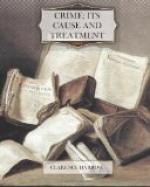XXVI
THE DEFECTIVE AND INSANE
It is almost hopeless to bring any system or order out of the chaos that prevails in the discussion of the insane, the defective, the moron, and the feeble-minded. The world has so long believed that man is a specially created animal and that he does wrong from free choice, that much more time and investigation are necessary before sane and scientific theories can be formulated on this subject.
It has been a great many years since any semi-intelligent man believed that all sorts of physical abnormalities were due to one cause and could be cured by one method, and yet the prevailing opinion now, even among the fairly educated, is that all sorts of abnormal conduct are due to one cause, perversity and wickedness, and should be treated with only one prescription, punishment. Scientific men indeed have long known that there were causes for the abnormality of conduct and that there were various more or less satisfactory remedies for many cases. Still the time that scientists have worked on the problem is short and the data imperfect, and many years of patient study will be needed before there can be worked out the broad theories of responsibility for and treatment of crime which will replace the long accepted doctrines of original sin, and the expulsion of devils from the wicked by cruelty and punishment.
By far the largest part of the population of prisons is made up of the insane, feeble-minded, morons, defectives or victims of diseases that seriously influence conduct. This is especially shown by the increased percentage of the clearly defective that are repeaters, over those in prison for their first offense. There is no lack of statistics as to the various groups of defectives, but these figures cannot be reconciled. No two authorities agree as to percentages; the classifications are more or less uncertain; the dividing lines between the different groups are vague, one class easily fading into another. The investigations have largely been made by those not trained for the work, and above all the conclusions as to treatment are at variance, doubtful and necessarily not yet satisfactory.




